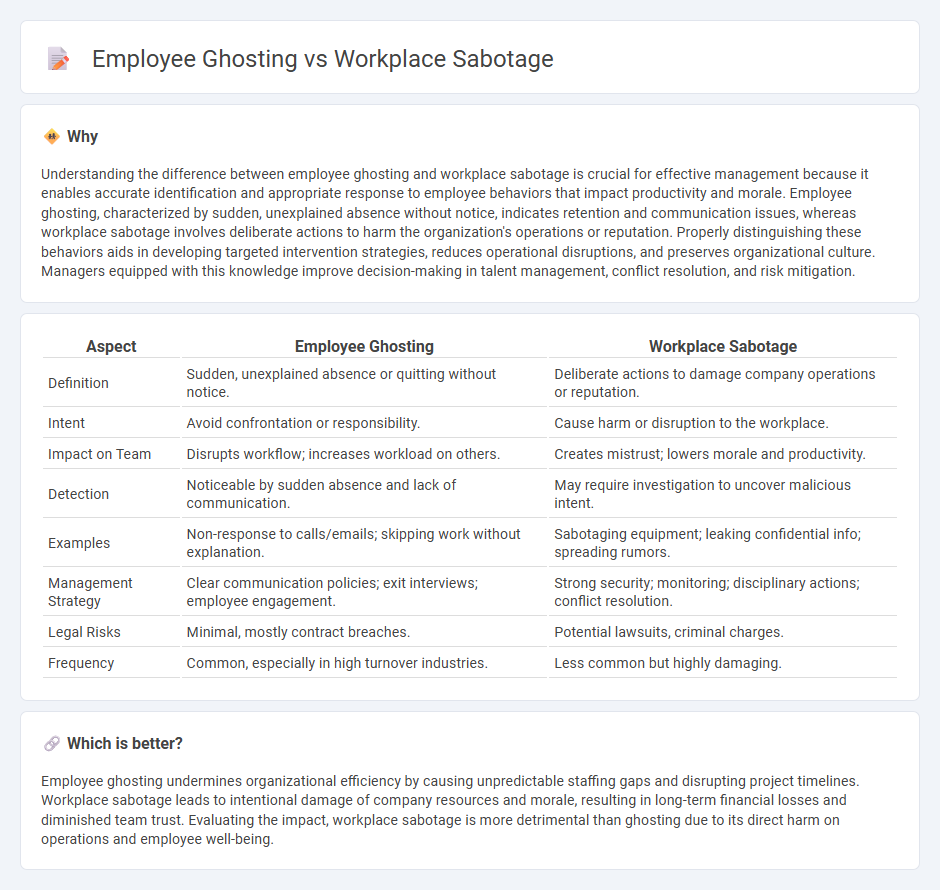
Employee ghosting, characterized by sudden and unexplained absence from work, disrupts team dynamics and project timelines, leading to increased management challenges and operational inefficiencies. Workplace sabotage involves deliberate actions that harm company resources or morale, resulting in diminished productivity and heightened conflict among employees. Discover effective strategies to address and prevent these issues in modern management practices.
Why it is important
Understanding the difference between employee ghosting and workplace sabotage is crucial for effective management because it enables accurate identification and appropriate response to employee behaviors that impact productivity and morale. Employee ghosting, characterized by sudden, unexplained absence without notice, indicates retention and communication issues, whereas workplace sabotage involves deliberate actions to harm the organization's operations or reputation. Properly distinguishing these behaviors aids in developing targeted intervention strategies, reduces operational disruptions, and preserves organizational culture. Managers equipped with this knowledge improve decision-making in talent management, conflict resolution, and risk mitigation.
Comparison Table
| Aspect | Employee Ghosting | Workplace Sabotage |
|---|---|---|
| Definition | Sudden, unexplained absence or quitting without notice. | Deliberate actions to damage company operations or reputation. |
| Intent | Avoid confrontation or responsibility. | Cause harm or disruption to the workplace. |
| Impact on Team | Disrupts workflow; increases workload on others. | Creates mistrust; lowers morale and productivity. |
| Detection | Noticeable by sudden absence and lack of communication. | May require investigation to uncover malicious intent. |
| Examples | Non-response to calls/emails; skipping work without explanation. | Sabotaging equipment; leaking confidential info; spreading rumors. |
| Management Strategy | Clear communication policies; exit interviews; employee engagement. | Strong security; monitoring; disciplinary actions; conflict resolution. |
| Legal Risks | Minimal, mostly contract breaches. | Potential lawsuits, criminal charges. |
| Frequency | Common, especially in high turnover industries. | Less common but highly damaging. |
Which is better?
Employee ghosting undermines organizational efficiency by causing unpredictable staffing gaps and disrupting project timelines. Workplace sabotage leads to intentional damage of company resources and morale, resulting in long-term financial losses and diminished team trust. Evaluating the impact, workplace sabotage is more detrimental than ghosting due to its direct harm on operations and employee well-being.
Connection
Employee ghosting and workplace sabotage are interconnected through their impact on organizational trust and productivity. Ghosting, where employees abruptly cease communication or attendance, often breeds resentment and disrupts team dynamics, creating fertile ground for sabotage behaviors. This erosion of mutual respect undermines collaboration, leading to decreased morale and increased operational inefficiencies.
Key Terms
Organizational Culture
Workplace sabotage often stems from a toxic organizational culture characterized by mistrust, lack of communication, and unresolved conflicts, leading to deliberate harm to company operations or colleagues. In contrast, employee ghosting reflects disengagement and dissatisfaction, indicating deeper issues like poor management and lack of support within the organizational culture. Explore how cultivating a positive and transparent organizational culture can prevent both sabotage and ghosting to enhance overall workplace health.
Employee Engagement
Workplace sabotage undermines employee engagement by creating a hostile environment, reducing trust and collaboration among team members, while employee ghosting disrupts workflow and hampers morale due to sudden, unexplained absences. Both behaviors significantly impact productivity and retention, making it essential for organizations to implement proactive engagement strategies and clear communication channels. Discover effective methods to address these challenges and foster a resilient, engaged workforce.
Retention Strategies
Workplace sabotage involves deliberate actions by employees to disrupt operations, while employee ghosting refers to staff suddenly abandoning their roles without notice. Effective retention strategies must address underlying job dissatisfaction and foster transparent communication to prevent both disengagement forms. Explore proven retention tactics to safeguard your workforce and minimize turnover impact.
Source and External Links
Recognizing and Addressing Workplace Sabotage - Workplace sabotage occurs when someone intentionally harms a colleague's work or reputation through actions like spreading false information, leaving others out of important meetings, or creating purposeful mistakes, leading to a toxic environment.
Signs of Sabotage in the Workplace - Visotsky Inc - Sabotage disrupts normal work processes through deliberate or unconscious actions such as constant delays, refusal to cooperate, or poor-quality work, which undermine team trust, productivity, and can drive away skilled employees.
What Drives Managers to Sabotage Talented Employees - Research shows managers sometimes sabotage talented subordinates, often motivated by concerns over status or power rather than financial gain, with sabotage more common in workplaces using relative performance evaluations.
 dowidth.com
dowidth.com